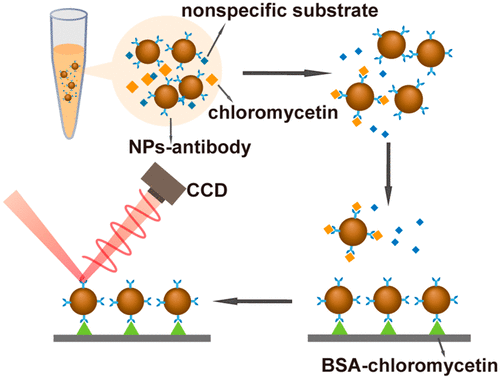当前位置:
X-MOL 学术
›
Anal. Chem.
›
论文详情
Our official English website, www.x-mol.net, welcomes your
feedback! (Note: you will need to create a separate account there.)
Nanoparticles-Enabled Surface-Enhanced Imaging Ellipsometry for Amplified Biosensing.
Analytical Chemistry ( IF 6.7 ) Pub Date : 2019-05-03 00:00:00 , DOI: 10.1021/acs.analchem.9b00846
Zhilong Wang 1 , Yunlei Xianyu 2 , Wei Liu 3 , Yike Li 3 , Zhaoxia Cai 1 , Xing Fu 1 , Gang Jin 3 , Yu Niu 3 , Cai Qi 4 , Yiping Chen 1
Analytical Chemistry ( IF 6.7 ) Pub Date : 2019-05-03 00:00:00 , DOI: 10.1021/acs.analchem.9b00846
Zhilong Wang 1 , Yunlei Xianyu 2 , Wei Liu 3 , Yike Li 3 , Zhaoxia Cai 1 , Xing Fu 1 , Gang Jin 3 , Yu Niu 3 , Cai Qi 4 , Yiping Chen 1
Affiliation

|
The main issues of imaging ellipsometry-based biosensing for small molecules are the low sensitivity and narrow detection range due to the low molecular weight of small molecules that results in a negligible signal. To meet this challenge, we theoretically investigated the deciding factors of the ellipsometry signal and further applied the theory to guide the design of ellipsometry-based biosensor using metal nanoparticles that have a high dielectric constant. Significant signal amplification effects can be achieved by using nanoparticle labels including magnetic nanoparticles and gold nanoparticles. Guided by the theory, we have developed a sensitive surface-enhanced imaging ellipsometry (SEIE)-biosensor for detecting chloramphenicol in real milk sample with high sensitivity (with a limit of detection of 6 pg/mL) and broaden detection range. This nanoparticles-enabled SEIE not only greatly improves the sensitivity of conventional imaging ellipsometry-based biosensors but also retains the advantages of conventional methods in terms of automated and convenient operation, providing an effective strategy for detection of trace small molecules in complex samples that holds great promise in scientific research, clinical diagnosis, and food safety.
中文翻译:

用于放大的生物传感的启用纳米粒子的表面增强成像椭偏仪。
对于小分子,基于椭圆偏振成像的生物传感成像的主要问题是低灵敏度和狭窄的检测范围,这是由于小分子的分子量低,导致信号可忽略不计。为了应对这一挑战,我们在理论上研究了椭偏信号的决定因素,并进一步将该理论应用于具有高介电常数的金属纳米粒子的基于椭偏的生物传感器的设计。通过使用包括磁性纳米颗粒和金纳米颗粒的纳米颗粒标记,可以实现显着的信号放大效果。在该理论的指导下,我们开发了一种灵敏的表面增强成像椭圆光度法(SEIE)生物传感器,以高灵敏度(检测限为6 pg / mL)检测真乳样品中的氯霉素,并扩大了检测范围。
更新日期:2019-05-03
中文翻译:

用于放大的生物传感的启用纳米粒子的表面增强成像椭偏仪。
对于小分子,基于椭圆偏振成像的生物传感成像的主要问题是低灵敏度和狭窄的检测范围,这是由于小分子的分子量低,导致信号可忽略不计。为了应对这一挑战,我们在理论上研究了椭偏信号的决定因素,并进一步将该理论应用于具有高介电常数的金属纳米粒子的基于椭偏的生物传感器的设计。通过使用包括磁性纳米颗粒和金纳米颗粒的纳米颗粒标记,可以实现显着的信号放大效果。在该理论的指导下,我们开发了一种灵敏的表面增强成像椭圆光度法(SEIE)生物传感器,以高灵敏度(检测限为6 pg / mL)检测真乳样品中的氯霉素,并扩大了检测范围。































 京公网安备 11010802027423号
京公网安备 11010802027423号